![]()
Chinese Paperweights for Sale
![]()
Chinese Paperweights for Sale
This group of paperweights is a representative sample of the Chinese Paperweights made in the late 1920s and throughout the 1930s as an attempt to duplicate 19th Century antique weights made in the United States and France. Because they are almost 100 years old, they are very collectible. Every collector should own a few of these as study pieces. I have also included some other Chinese paperweights that are newer or uniquely Chinese.
The history of the early Chinese paperweights is mostly anecdotal as no written records have been discovered. The story is that an American dealer sent examples of paperweights made by the New England Glass Company (NEGC), Boston & Sandwich Glass Company (B&S), Millville makers, and French factories to a Chinese factory and requested copies be made. The results are interesting and sometimes confused with the originals by inexperienced collectors. The earliest pictures of these paperweights appeared in the book American Glass Paperweights by Francis Edgar Smith published in 1939. Smith was aware that at least one of the paperweights shown in his book was Chinese. Since Smith was not an expert collector, this indicates that there was some general knowledge that these were Chinese prior to 1939.
In the United States, the Tariff Act of 1930 required that every imported item must be conspicuously and indelibly marked in English with its country of origin. As a result, many of these Chinese paperweights are scratch signed on the bottom "CHINA". Many are also not signed, suggesting that either they were imported prior to 1930 or the importer ignored the requirement. Most likely the earliest Chinese paperweights were made prior to 1930.
The Chinese makers often combined design features found in paperweights from different makers. For example they copied the latticinio grounds used by New England Glass Company and used them with copies of Baccarat Pansy weights. The original Baccarat pansy paperweights never had a latticinio ground. They copied the pedestal rose from Millville and then used the pedestal bottom with other weights. It is fun to collect all the variations.
Most have a light weight glass mixture that is high in soda and has a greenish tinge. The glass also has a soft almost oily feel. Frequently they have bubbles or debris in the glass. And because of their age, many of these have minor scratches or other surface defects.
For more information on Chinese paperweights, there is a great chapter on Chinese paperweights in the book World Paperweights: Millefiori and Lampwork by Robert Hall. The book includes a price guide. For this and other great references on paperweights, check out my list of paperweight books for sale.
If you are interested in
purchasing any of these paperweights, e-mail Allan Port at: aport@paperweights.com
| 1416 | Chinese 1930 Double Marble with Red
Flower Aquarium Paperweight. circa 1930.
This paperweight features a double marble inside with a delightful
red flower on top of the design. The red flower has a yellow
millefiori center. This is a uniquely Chinese
invention. It is intended to be placed in an aquarium
along with the rocks and plants. The inner two spheres
inside resemble a double marble. Novelty items like this
started appearing in the US in the 1930s and some were sold at the
1939 World's Fair and I believe this is an early example.
Scratch signed "CHINA" on the base. A fun collectible. Note: This paperweight is delightful but its unusual shape caused some distortion and kept me from getting great pictures. Chinese Paperweights were made in the late 1920s and throughout the 1930s as an attempt to duplicate 19th Century antique weights made in the United States and France. Because they are almost 100 years old, they are very collectible and every collector should own a few of these as study pieces. The history of the early Chinese paperweights is mostly anecdotal as no written records have been discovered. The story is that an American dealer sent examples of paperweights made by the New England Glass Company (NEGC), Boston &Sandwich Glass Company (B&S), Millville makers, and French factories to a Chinese factory and requested copies be made. The results are interesting and sometimes confused with the originals by inexperienced collectors. The earliest pictures of these paperweights appeared in the book American Glass Paperweights by Francis Edgar Smith published in 1939. Smith was aware that at least one of the paperweights shown in his book was Chinese. Since Smith was not an expert collector, this indicates that there was some general knowledge that these were Chinese prior to 1939. In the United States, the Tariff Act of 1930 required that every imported item must be conspicuously and indelibly marked in English with its country of origin. As a result, many of these Chinese paperweights are scratch signed on the bottom "CHINA". Many are also not signed, suggesting that either they were imported prior to 1930 or the importer ignored the requirement. Most likely the earliest Chinese paperweights were made prior to 1930. Size: Larger than most aquarium paperweights, this
example is just under 2" diameter by 1 3/4" high. For extra pictures, click on the picture at the right and the following links: Large picture$149 postage paid in the US. Click on the picture to see a larger image. |
Click
on the picture to see a larger image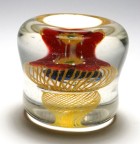 |
| 1868 | Rare 1930s Chinese Butterfly
Paperweight. circa 1930. This paperweight
features a red winged lampwork butterfly flying with wings
extended over millefiori frit ground. The wings are covered
with multi-colored dots. The butterfly body is light blue
with two well defined antennae. The frit ground consists of
millefiori cane slices. This paperweight is signed on the
base with a scratch signature "CHINA". A great example. Note: Please ignore the white areas, they are glare from the lights. Chinese Paperweights were made in the late 1920s and throughout the 1930s as an attempt to duplicate 19th Century antique weights made in the United States and France. Because they are almost 100 years old, they are very collectible and every collector should own a few of these as study pieces. The history of the early Chinese paperweights is mostly anecdotal as no written records have been discovered. The story is that an American dealer sent examples of paperweights made by the New England Glass Company (NEGC), Boston &Sandwich Glass Company (B&S), Millville makers, and French factories to a Chinese factory and requested copies be made. The results are interesting and sometimes confused with the originals by inexperienced collectors. The earliest pictures of these paperweights appeared in the book American Glass Paperweights by Francis Edgar Smith published in 1939. Smith was aware that at least one of the paperweights shown in his book was Chinese. Since Smith was not an expert collector, this indicates that there was some general knowledge that these were Chinese prior to 1939. In the United States, the Tariff Act of 1930 required that every imported item must be conspicuously and indelibly marked in English with its country of origin. As a result, many of these Chinese paperweights are scratch signed on the bottom "CHINA". Many are also not signed, suggesting that either they were imported prior to 1930 or the importer ignored the requirement. Most likely the earliest Chinese paperweights were made prior to 1930. The Chinese makers often combined design features found in paperweights from different makers. For example they copied the latticinio grounds used by New England Glass Company and used them with copies of Baccarat Pansy weights. The original Baccarat pansy paperweights never had a latticinio ground. They copied the pedestal rose from Millville and then used the pedestal bottom with other weights. It is fun to collect all the variations. In general, Chinese paperweights from the
1930s have a light weight glass mixture that is high in soda
and has a greenish tinge. The glass also has a soft almost
oily feel. Frequently they have bubbles or debris in the
glass. And because of their age, many of these have
minor scratches or other surface defects. Chinese
paperweights made in the 1970s and later usually have better
quality glass and are free of debris. Medium Size: Just over 2 1/2" diameter by just
under 1 3/4" high. The bottom is ground flat. For extra pictures, click on the picture at the right and the following links: Large picture$49 postage paid in the US. Click on the picture to see a larger image. |
Click
on the picture to see a larger image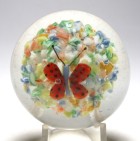 |
| 1585 | Very Rare Chinese Quatrefoil Faceted
Blue Flower with Bud on Double Latticinio Paperweight - copy of
NEGC. circa 1930. This is an almost antique
Chinese copy of a New England Glass Company (NEGC) Blue Flower
with Bud Paperweight made circa 1860. It has the fancy NEGC
quatrefoil faceting and double latticinio ground. There is a
blue flower with five petals and a millefiori center and also a
large blue bud and two large green leaves and a stem. The
design is set on a great double latticinio ground. The
paperweight is faceted with a four part top facet and eight side
facets (four large and four smaller). This is a fantastic
addition to any collection of antique paperweights. In some
ways, the execution of this example is better than the original
NEGC, since NEGC examples often have large bubbles or other
defects in the latticinio.
Chinese Paperweights were made in the late 1920s and throughout the 1930s as an attempt to duplicate 19th Century antique weights made in the United States and France. Because they are almost 100 years old, they are very collectible and every collector should own a few of these as study pieces. The history of the early Chinese paperweights is mostly anecdotal as no written records have been discovered. The story is that an American dealer sent examples of paperweights made by the New England Glass Company (NEGC), Boston & Sandwich Glass Company (B&S), Millville makers, and French factories to a Chinese factory and requested copies be made. The results are interesting and sometimes confused with the originals by inexperienced collectors. The earliest pictures of these paperweights appeared in the book American Glass Paperweights by Francis Edgar Smith published in 1939. Smith was aware that at least one of the paperweights shown in his book was Chinese. Since Smith was not an expert collector, this indicates that there was some general knowledge that these were Chinese prior to 1939. In the United States, the Tariff Act of 1930 required that every imported item must be conspicuously and indelibly marked in English with its country of origin. As a result, many of these Chinese paperweights are scratch signed on the bottom "CHINA". Many are also not signed, suggesting that either they were imported prior to 1930 or the importer ignored the requirement. Most likely the earliest Chinese paperweights were made prior to 1930. The Chinese makers often combined design features found in paperweights from different makers. For example they copied the latticinio grounds used by New England Glass Company and used them with copies of Baccarat Pansy weights. The original Baccarat pansy paperweights never had a latticinio ground. They copied the pedestal rose from Millville and then used the pedestal bottom with other weights. It is fun to collect all the variations. In general, Chinese paperweights from this period have a light weight glass mixture that is high in soda and has a greenish tinge. The glass also has a soft almost oily feel. Frequently they have bubbles or debris in the glass. And because of their age, many of these have minor scratches or other surface defects. Large Size: Just under 2 5/8" diameter by 1
7/82" high. The bottom is ground concave. For extra pictures, click on the picture at the right and the following links: Large picture$295 postage paid in the US. Click on the picture to see a larger image. |
Click
on the picture to see a larger image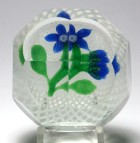 |
| 1700 | Magnum Chinese Copy of the Famous Clichy
Millefiori Basket - Heart Shaped. Circa 2000.
This very large millefiori paperweight has a basket form with a
heart shaped top. The top is bulging with flowers arranged
in a complex millefiori garland pattern on a moss ground.
The top is edged with a reddish orange and white torsade
lip. The sides of the basket are formed using green and
white staves and the base also has a reddish orange and white
torsade lip. It was originally marketed on the QVC
television network and was sold as a "lamp" with a lighted
stand. This copy does not have the stand. A fun
addition to any collection of glass paperweights. Note: While the resemblance to the antique Clichy basket paperweight is unmistakable, this paperweight is considerably larger than the original which was only 4 1/4" in diameter. The original antique was oval shaped rather than heart shaped. The original Clichy antique held the record for the most expensive paperweight ever sold. It sold for $258,500 to a private collector at a Sotheby's auction in New York on June 26, 1990. Unfortunately it was dropped and damaged beyond repair. You can see the cover of the Sotheby's auction with a picture of the Clichy basket at this link: Sotheby's Catalog Very large size: 7 1/2" wide by 7" deep by 3 7/8"
high. The base is ground flat. It weighs 102 ounces
(six pounds six ounces) and will be approximately eight pounds
when boxed for mailing. For extra pictures, click on the picture at the right and the following links: Large picture$275 plus postage. For this item, because of the weight (8 pounds packaged), the buyer will pay the postage. US Sales only, no international shipping. Click on the picture to see a larger image. |
Click
on the picture to see a larger image |
| 842 | Magnum 1930s Chinese Scrambled Millefiori
Paperweight. circa 1930. This is an extra large
example of a 1930s scrambled millefiori paperweight from China
filled with a nice assortment of millefiori canes and twist
canes. This style was intended to be a copy of a French
scramble or end of day weight from 1845-1860 (probably St. Louis
or Clichy), but it will not fool today's collectors. This
example is scratch signed "CHINA" on the base. As
with most Chinese paperweights of this period, this paperweight
has a light weight glass mixture that is high in soda and has a
greenish tinge. The glass has a soft oily feel and there are many light scratches and scuff
marks. There are also striations (sugaring) in the
glass. An unusually large example worthy of any collection
of Chinese paperweights. Chinese Paperweights were made in the late 1920s and throughout the 1930s as an attempt to duplicate 19th Century antique weights made in the United States and France. Because they are almost 100 years old, they are very collectible and every collector should own a few of these as study pieces. The history of the early Chinese paperweights is mostly anecdotal as no written records have been discovered. The story is that an American dealer sent examples of paperweights made by the New England Glass Company (NEGC), Boston & Sandwich Glass Company (B&S), Millville makers, and French factories to a Chinese factory and requested copies be made. The results are interesting and sometimes confused with the originals by inexperienced collectors. The earliest pictures of these paperweights appeared in the book American Glass Paperweights by Francis Edgar Smith published in 1939. Smith was aware that at least one of the paperweights shown in his book was Chinese. Since Smith was not an expert collector, this indicates that there was some general knowledge that these were Chinese prior to 1939. In the United States, the Tariff Act of 1930 required that every imported item must be conspicuously and indelibly marked in English with its country of origin. As a result, many of these Chinese paperweights are scratch signed on the bottom "CHINA". Many are also not signed, suggesting that either they were imported prior to 1930 or the importer ignored the requirement. Most likely the earliest Chinese paperweights were made prior to 1930. The Chinese makers often combined design features found in paperweights from different makers. For example they copied the latticinio grounds used by New England Glass Company and used them with copies of Baccarat Pansy weights. The original Baccarat pansy paperweights never had a latticinio ground. They copied the pedestal rose from Millville and then used the pedestal bottom with other weights. It is fun to collect all the variations. In general, Chinese paperweights from the 1930s have a light weight glass mixture that is high in soda and has a greenish tinge. The glass also has a soft almost oily feel. Frequently they have bubbles or debris in the glass. And because of their age, many of these have minor scratches or other surface defects. Chinese paperweights made in the 1970s and later usually have better quality glass and are free of debris.
Very large size: Just under 3 7/16” diameter
by 2 7/16" high. The base is rough, fire finished,
and ground concave in the center. A remnant of the pontil
scar remains in the center. For extra pictures, click on the picture at the right and the following links: Large picture$125 postage paid in the US. Click on the picture to see a larger image. |
Click
on the picture to see a larger image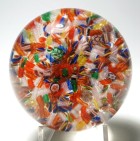 |
| 4078 | Old Chinese Two Color Fantasy Flower
Paperweight with Leaves and Bud - Copy of Baccarat Antique.
circa 1930. This is a copy of a French Baccarat 12
petal fantasy flower paperweight with bud made in the classic
period from 1845-1860. The two color flower has a complex
millefiori center cane, five leaves, two color bud, and a
stem. The ground is clear. The style dates from the
1920s or 1930s and is almost an antique.
Chinese Paperweights were made in the late 1920s and throughout the 1930s as an attempt to duplicate 19th Century antique weights made in the United States and France. Because they are almost 100 years old, they are very collectible and every collector should own a few of these as study pieces. The history of the early Chinese paperweights is mostly anecdotal as no written records have been discovered. The story is that an American dealer sent examples of paperweights made by the New England Glass Company (NEGC), Boston & Sandwich Glass Company (B&S), Millville makers, and French factories to a Chinese factory and requested copies be made. The results are interesting and sometimes confused with the originals by inexperienced collectors. The earliest pictures of these paperweights appeared in the book American Glass Paperweights by Francis Edgar Smith published in 1939. Smith was aware that at least one of the paperweights shown in his book was Chinese. Since Smith was not an expert collector, this indicates that there was some general knowledge that these were Chinese prior to 1939. In the United States, the Tariff Act of 1930 required that every imported item must be conspicuously and indelibly marked in English with its country of origin. As a result, many of these Chinese paperweights are scratch signed on the bottom "CHINA". Many are also not signed, suggesting that either they were imported prior to 1930 or the importer ignored the requirement. Most likely the earliest Chinese paperweights were made prior to 1930. The Chinese makers often combined design features found in paperweights from different makers. For example they copied the latticinio grounds used by New England Glass Company and used them with copies of Baccarat Pansy weights. The original Baccarat pansy paperweights never had a latticinio ground. They copied the pedestal rose from Millville and then used the pedestal bottom with other weights. It is fun to collect all the variations. In general, Chinese paperweights from this period have a light weight glass mixture that is high in soda and has a greenish tinge. The glass also has a soft almost oily feel. Frequently they have bubbles or debris in the glass. And because of their age, many of these have minor scratches or other surface defects. Size: Just under 2 3/4" diameter by 1/4"
high. The base is ground concave in the center. $45 postage paid in the US. Click on the picture to see a larger image. |
Click on the picture
to see a larger image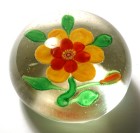 |
|
|
Signed 1930s Chinese Closepack
Millefiori Paperweight. c.1930. This is a copy of a French
antique paperweight from 1845-1860. Most likely it was based
on a Clichy closepack design. Clear ground. A nice
example with great color.
Please ignore the white areas, they are glare from the lights. Large Size: 2 7/8” diameter by just under 1
1/2" high. For extra pictures, click on the picture at the right and the following links: Large picture of the paperweight$55 postage paid in the US. Click on the picture to see a larger image. |
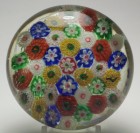 |
| 2012 | Chinese Miniature Orange Butterfly on
Green Ground Paperweight. circa 1940 - 1960.
This paperweight features an orange and yellow winged lampwork
butterfly flying with wings extended over a green frit
ground. The butterfly body is light green with two well
defined antennae. The green ground gives the glass a
greenish tinge, but it is mostly clear glass. This
paperweight is unsigned. Note: Please ignore the white areas, they are glare from the lights. Chinese Paperweights were made in the late 1920s and throughout the 1930s as an attempt to duplicate 19th Century antique weights made in the United States and France. Because they are almost 100 years old, they are very collectible and every collector should own a few of these as study pieces. The history of the early Chinese paperweights is mostly anecdotal as no written records have been discovered. The story is that an American dealer sent examples of paperweights made by the New England Glass Company (NEGC), Boston &Sandwich Glass Company (B&S), Millville makers, and French factories to a Chinese factory and requested copies be made. The results are interesting and sometimes confused with the originals by inexperienced collectors. The earliest pictures of these paperweights appeared in the book American Glass Paperweights by Francis Edgar Smith published in 1939. Smith was aware that at least one of the paperweights shown in his book was Chinese. Since Smith was not an expert collector, this indicates that there was some general knowledge that these were Chinese prior to 1939. In the United States, the Tariff Act of 1930 required that every imported item must be conspicuously and indelibly marked in English with its country of origin. As a result, many of these Chinese paperweights are scratch signed on the bottom "CHINA". Many are also not signed, suggesting that either they were imported prior to 1930 or the importer ignored the requirement. Most likely the earliest Chinese paperweights were made prior to 1930. The Chinese makers often combined design features found in paperweights from different makers. For example they copied the latticinio grounds used by New England Glass Company and used them with copies of Baccarat Pansy weights. The original Baccarat pansy paperweights never had a latticinio ground. They copied the pedestal rose from Millville and then used the pedestal bottom with other weights. It is fun to collect all the variations. In general, Chinese paperweights from the
1930s have a light weight glass mixture that is high in soda
and has a greenish tinge. The glass also has a soft almost
oily feel. Frequently they have bubbles or debris in the
glass. And because of their age, many of these have
minor scratches or other surface defects. Chinese
paperweights made in the 1970s and later usually have better
quality glass and are free of debris. Miniature size: 2" diameter by 1 5/8"
high. The bottom is flat with remnants of the pontil scar.
For extra pictures, click on the picture at the right and the following links: Large picture$39 postage paid in the US. Click on the picture to see a larger image. |
Click on the picture to see a larger image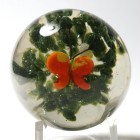 |
| 1788 | Rare Chinese Copy of a NEGC Faceted
Millefiori Nosegay Paperweight. circa 1930. This
is an almost antique Chinese copy of a New England Glass Company
(NEGC) Posy Paperweight made circa 1860. It has the fancy
NEGC quatrefoil faceting and setup. The millefiori nosegay
consists of three red, blue, and yellow complex millefiori canes
with four green leaves and a stem. All this surrounded by
two garlands of complex millefiori, one made up of alternating
pink and blue millefiori canes, the other made up of identical
pink and white flowers with green centers. This great setup
is on top of a latticinio swirl ground. There are twelve
side facets (four large and eight smaller) plus the four part top
facet with a notch between each. This is a fantastic
addition to any collection of antique paperweights. In some
ways, the execution of this example is better than the original
NEGC, since NEGC examples usual have tipped or cracked canes and
the posy is often smudged. Chinese Paperweights were made in the late 1920s and throughout the 1930s as an attempt to duplicate 19th Century antique weights made in the United States and France. Because they are almost 100 years old, they are very collectible and every collector should own a few of these as study pieces. The history of the early Chinese paperweights is mostly anecdotal as no written records have been discovered. The story is that an American dealer sent examples of paperweights made by the New England Glass Company (NEGC), Boston & Sandwich Glass Company (B&S), Millville makers, and French factories to a Chinese factory and requested copies be made. The results are interesting and sometimes confused with the originals by inexperienced collectors. The earliest pictures of these paperweights appeared in the book American Glass Paperweights by Francis Edgar Smith published in 1939. Smith was aware that at least one of the paperweights shown in his book was Chinese. Since Smith was not an expert collector, this indicates that there was some general knowledge that these were Chinese prior to 1939. Large Size: 2 7/8" diameter by 1 15/16"
high. The bottom is ground concave. For extra pictures, click on the picture at the right and the following links: Large picture$175 postage paid in the US. Click on the picture to see a larger image. |
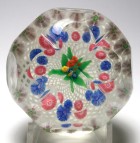 |
| 1447 | Chinese Concentric Millefiori
Paperweight. circa 1930. This is a copy of a Clichy
paperweight from France made in the classic period from
1845-1860. Clear ground. This type is not as common as the
other patterned millefiori weights, nor is it as intricate.
The millefiori canes are simple canes. Perhaps it was made
later or perhaps by a different factory.
Small Size: 2 3/8” diameter by just under 1 7/8”
high. For extra pictures, click on the picture at the right and the following links: Large picture of the paperweight$35 postage paid in the US. Click on the picture to see a larger image. |
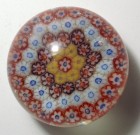 |
| 2238 | Chinese Millefiori Perfume Bottle or
Inkwell. c.1930. Matching concentric millefiori
pattern in the base and the stopper. Each has four rings of
millefiori around a central floral cane. The base is
footed. I would call this bottle a scent or perfume bottle
because of the long stopper that reaches almost to the bottom of
the well. A very desirable Chinese paperweight collectible.
This is a copy of a Whitefriars inkwell from about 1920. You can see the Whitefriars version by clicking this link. Note the similarity right down to the footed base. Size: 3 1/8" diameter by 5 1/2" high. Excellent condition with only minor wear consistent with age. As is typical of Chinese paperweights from this period, there is some debris in the glass and it has a greenish hue. For comparable pricing, check lot 288 in Selman's Fall 2002 auction, in which a similar sized bottle brought $303 against an estimate of $275-$400. For extra pictures, click on the picture at the right and the following links: Large picture of the paperweight$150 postage paid in the US. Price reduced (was $195) Click on the picture to see a larger image. |
Click on the picture
to see a larger image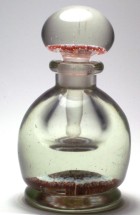 |
| 1568 | 1930s Chinese Millefiori Brushholder
Paperweight. circa 1930-1940. This is another
uniquely Chinese invention. This has also been described as
a chopstick holder. Novelty items like this started
appearing in the US in the 1930s and some were sold at the 1939
World's Fair. I call this shape the lotus flower
shape. It has a floral shape with applied petals around the
outside.
Size: 2 1/8" diameter by 1 1/3" high. For extra pictures, click on the picture at the right and the followinglinks: Large picture of the paperweight$39 postage paid in the US. Click on the picture to see a larger image. |
Click
on the picture to see a larger image |
| 1472 | Unusual Miniature Chinese Mosaic
Millefiori Paperweight with Rose Cane. circa
1950-70. Unusual Chinese millefiori with mosaic canes.
There are red and yellow star canes surrounded by leaf canes and a
single rose cane. I have no idea what the pattern is
supposed to represent. Very little is known about this
style. Other examples have a butterfly pattern and some have
Chinese writing in the design. The style is believed to be
from 1950-1970.
Chinese Paperweights were made in the late 1920s and throughout the 1930s as an attempt to duplicate 19th Century antique weights made in the United States and France. Because they are almost 100 years old, they are very collectible and every collector should own a few of these as study pieces. The history of the early Chinese paperweights is mostly anecdotal as no written records have been discovered. The story is that an American dealer sent examples of paperweights made by the New England Glass Company (NEGC), Boston & Sandwich Glass Company (B&S), Millville makers, and French factories to a Chinese factory and requested copies be made. The results are interesting and sometimes confused with the originals by inexperienced collectors. The earliest pictures of these paperweights appeared in the book American Glass Paperweights by Francis Edgar Smith published in 1939. Smith was aware that at least one of the paperweights shown in his book was Chinese. Since Smith was not an expert collector, this indicates that there was some general knowledge that these were Chinese prior to 1939. In the United States, the Tariff Act of 1930 required that every imported item must be conspicuously and indelibly marked in English with its country of origin. As a result, many of these Chinese paperweights are scratch signed on the bottom "CHINA". Many are also not signed, suggesting that either they were imported prior to 1930 or the importer ignored the requirement. Most likely the earliest Chinese paperweights were made prior to 1930. The Chinese makers often combined design features found in paperweights from different makers. For example they copied the latticinio grounds used by New England Glass Company and used them with copies of Baccarat Pansy weights. The original Baccarat pansy paperweights never had a latticinio ground. They copied the pedestal rose from Millville and then used the pedestal bottom with other weights. It is fun to collect all the variations. In general, Chinese paperweights from the earliest period (1930-1950) have a light weight glass mixture that is high in soda and has a greenish tinge. The glass also has a soft almost oily feel. Frequently they have bubbles or debris in the glass. And because of their age, many of these have minor scratches or other surface defects. This paperweight has a slightly better glass, but it is not crystal clear like modern paperweights. Miniature Size: 1 13/16" diameter by 1 1/2"
high. The bottom is ground flat. For extra pictures, click on the picture at the right and the following links: Large picture$39 postage paid in the US. Click on the picture to see a larger image. |
Click
on the picture to see a larger image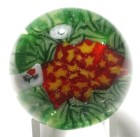 |
| 4748 | Miniature 1930s Chinese
Millefiori Brushholder Paperweight - Aladdin's Lamp Shape.
c.1930-1940. This is another uniquely Chinese invention,
although one that adopted the use of millefiori found in
paperweights from other countries. This has also been
described as a chopstick holder. Novelty items like this
started appearing in the US in the 1930s and some were sold at the
1939 World's Fair. I call this shape the Aladdin's lamp
shape. A fun collectible. Chinese Paperweights were made in the late 1920s and throughout the 1930s as an attempt to duplicate 19th Century antique weights made in the United States and France. Because they are almost 100 years old, they are very collectible and every collector should own a few of these as study pieces. The history of the early Chinese paperweights is mostly anecdotal as no written records have been discovered. The story is that an American dealer sent examples of paperweights made by the New England Glass Company (NEGC), Boston &Sandwich Glass Company (B&S), Millville makers, and French factories to a Chinese factory and requested copies be made. The results are interesting and sometimes confused with the originals by inexperienced collectors. The earliest pictures of these paperweights appeared in the book American Glass Paperweights by Francis Edgar Smith published in 1939. Smith was aware that at least one of the paperweights shown in his book was Chinese. Since Smith was not an expert collector, this indicates that there was some general knowledge that these were Chinese prior to 1939. In the United States, the Tariff Act of 1930 required that every imported item must be conspicuously and indelibly marked in English with its country of origin. As a result, many of these Chinese paperweights are scratch signed on the bottom "CHINA". Many are also not signed, suggesting that either they were imported prior to 1930 or the importer ignored the requirement. Most likely the earliest Chinese paperweights were made prior to 1930. The Chinese makers often combined design features found in paperweights from different makers. For example they copied the latticinio grounds used by New England Glass Company and used them with copies of Baccarat Pansy weights. The original Baccarat pansy paperweights never had a latticinio ground. They copied the pedestal rose from Millville and then used the pedestal bottom with other weights. It is fun to collect all the variations. In general, Chinese paperweights from this period have a light weight glass mixture that is high in soda and has a greenish tinge. The glass also has a soft almost oily feel. Frequently they have bubbles or debris in the glass. And because of their age, many of these have minor scratches or other surface defects. Size: 2 1/2” long by 1 1/2" tall by 1 7/16"
deep. The base is ground flat. For extra pictures, click on the picture at the right and the following links: Large pictureSOLD. Added 8/20/2021 For more paperweights from China, see my Chinese Paperweights Web Page Click on the picture to see a larger image. |
Click
on the picture to see a larger image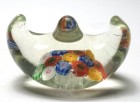 |
| 1693 | Rare Chinese Scramble Paperweight with
"MADE IN CHINA" Signature Canes. circa 1930. An
entertaining addition from China. Since this style was
intended to be a copy of a French scramble or end of day weight
from 1845-1860 (probably St. Louis or Clichy), it leaves you
wondering why they chose to add the "MADE IN CHINA" canes at the
bottom. Perhaps it was a response to the US customs
requirement that goods be marked with the country of origin in
English starting about 1930. Some importers complied by
scratch signing the word CHINA on the bottom. In any event,
this is a rare and welcome addition to any collection of Chinese
paperweights. As with most Chinese
paperweights, this paperweight has a light weight glass mixture
that is high in soda and has a greenish tinge. The glass has a
soft oily feel and there are some
light scratches. This example is especially colorful with
a nice variety of twist cans and millefiori slices. Special thanks to another collector who
pointed out that the words are actually word canes rather than
painted plaques. The lettering goes all the way through
the white background from top to bottom. You can see the
letters in reverse from the bottom. This is in contrast
to a painted plaque where the letters would be visible on only
the top surface. Chinese Paperweights were made in the late 1920s and throughout the 1930s as an attempt to duplicate 19th Century antique weights made in the United States and France. Because they are almost 100 years old, they are very collectible and every collector should own a few of these as study pieces. The history of the early Chinese paperweights is mostly anecdotal as no written records have been discovered. The story is that an American dealer sent examples of paperweights made by the New England Glass Company (NEGC), Boston & Sandwich Glass Company (B&S), Millville makers, and French factories to a Chinese factory and requested copies be made. The results are interesting and sometimes confused with the originals by inexperienced collectors. The earliest pictures of these paperweights appeared in the book American Glass Paperweights by Francis Edgar Smith published in 1939. Smith was aware that at least one of the paperweights shown in his book was Chinese. Since Smith was not an expert collector, this indicates that there was some general knowledge that these were Chinese prior to 1939. In the United States, the Tariff Act of 1930 required that every imported item must be conspicuously and indelibly marked in English with its country of origin. As a result, many of these Chinese paperweights are scratch signed on the bottom "CHINA". Many are also not signed, suggesting that either they were imported prior to 1930 or the importer ignored the requirement. Most likely the earliest Chinese paperweights were made prior to 1930. The Chinese makers often combined design features found in paperweights from different makers. For example they copied the latticinio grounds used by New England Glass Company and used them with copies of Baccarat Pansy weights. The original Baccarat pansy paperweights never had a latticinio ground. They copied the pedestal rose from Millville and then used the pedestal bottom with other weights. It is fun to collect all the variations. In general, Chinese paperweights from the 1930s have a light weight glass mixture that is high in soda and has a greenish tinge. The glass also has a soft almost oily feel. Frequently they have bubbles or debris in the glass. And because of their age, many of these have minor scratches or other surface defects. Chinese paperweights made in the 1970s and later usually have better quality glass and are free of debris.
Small Size: Just over 2 1/16” diameter by
just over 1 1/16" high. The base is fire finished
flat. For extra pictures, click on the picture at the right and the following links: Large picture$125 postage paid in the US. Click on the picture to see a larger image. |
Click
on the picture to see a larger image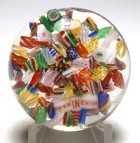 |
| 4457 | Chinese Aquarium Paperweight with Two
Fish and Foliage. circa 1930. This is a Chinese
invention. It is intended to be placed in an aquarium
along with the rocks and plants. The paperweight has two
blue and red fish plus an orange plant. It is roughly cube
shaped with rounded edges. Novelty items like this started
appearing in the US in the 1930s and some were sold at the 1939
World's Fair. This is a fun collectible. Chinese Paperweights were made in the late 1920s and throughout the 1930s as an attempt to duplicate 19th Century antique weights made in the United States and France. Because they are almost 100 years old, they are very collectible and every collector should own a few of these as study pieces. The history of the early Chinese paperweights is mostly anecdotal as no written records have been discovered. The story is that an American dealer sent examples of paperweights made by the New England Glass Company (NEGC), Boston & Sandwich Glass Company (B&S), Millville makers, and French factories to a Chinese factory and requested copies be made. The results are interesting and sometimes confused with the originals by inexperienced collectors. The earliest pictures of these paperweights appeared in the book American Glass Paperweights by Francis Edgar Smith published in 1939. Smith was aware that at least one of the paperweights shown in his book was Chinese. Since Smith was not an expert collector, this indicates that there was some general knowledge that these were Chinese prior to 1939. Chinese paperweights continued to be made throughout the 20th century and now into the 21st century with greatly improved quality. In the United States, the Tariff Act of
1930 required that every imported item must be conspicuously
and indelibly marked in English with its country of
origin. As a result, many of these Chinese paperweights
are scratch signed on the bottom "CHINA". Many are also
not signed, suggesting that either they were imported prior to
1930 or the importer ignored the requirement. Most
likely the earliest Chinese paperweights were made prior to
1930. In general, Chinese paperweights from the 1930s
have a light weight glass mixture that is high in soda and has
a greenish tinge. The glass also has a soft almost oily
feel. Frequently they have bubbles or debris in the
glass. And because of their age, many of these have
minor scratches or other surface defects. Chinese
paperweights made in the 1970s and later usually have better
quality glass and are free of debris. Size: 1 3/8" by 1 3/8" by 1 1/2" high. All
of the edges are rounded. The base is fire finished with
the remnant of a pontil mark. For extra pictures, click on the picture at the right and the following links: Large picture$45 postage paid in the US. Click on the picture to see a larger image. |
Click
on the picture to see a larger image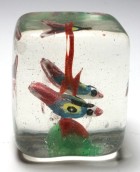 |
| 2128 | Rare Large Chinese White Paperweight
with Squirrel Eating Grapes. circa 1930. This
large Chinese white paperweight has a colored painting of squirrel
sitting upright and eating a luscious bunch of grapes. The
painting is created on a white enamel base and then encased in
glass. The style dates from the 1930s and is almost an
antique.
This paperweight is a form of Chinese folk art although it was most likely inspired by frit weights from Southern New Jersey. I believe the Chinese were given examples of Millville frit weights to duplicate. Since they were already experienced in painting on ceramics, they applied their own unique interpretation to paperweights using a white enamel disk as the base and incorporating familiar themes already found in Chinese art. Chinese Paperweights were made in the late 1920s and throughout the 1930s as an attempt to duplicate 19th Century antique weights made in the United States and France. Because they are almost 100 years old, they are very collectible and every collector should own a few of these as study pieces. The history of the early Chinese paperweights is mostly anecdotal as no written records have been discovered. The story is that an American dealer sent examples of paperweights made by the New England Glass Company (NEGC), Boston & Sandwich Glass Company (B&S), Millville makers, and French factories to a Chinese factory and requested copies be made. The results are interesting and sometimes confused with the originals by inexperienced collectors. The earliest pictures of these paperweights appeared in the book American Glass Paperweights by Francis Edgar Smith published in 1939. Smith was aware that at least one of the paperweights shown in his book was Chinese. Since Smith was not an expert collector, this indicates that there was some general knowledge that these were Chinese prior to 1939. In the United States, the Tariff Act of 1930 required that every imported item must be conspicuously and indelibly marked in English with its country of origin. As a result, many of these Chinese paperweights are scratch signed on the bottom "CHINA". Many are also not signed, suggesting that either they were imported prior to 1930 or the importer ignored the requirement. Most likely the earliest Chinese paperweights were made prior to 1930. In general, Chinese paperweights from this period have a light weight glass mixture that is high in soda and has a greenish tinge. The glass also has a soft almost oily feel. Frequently they have bubbles or debris in the glass. And because of their age, many of these have minor scratches or other surface defects. Large size: Just over 2 11/16" diameter by 1
7/8" high. The base is finished base. For extra pictures, click on the picture at the right and the following links: Large picture$195 postage paid in the US. Click on the picture to see a larger image. |
Click
on the picture to see a larger image |
| 1398 | Chinese Yellow Millefiori
Peacock Paperweight. circa 1945 -1970.
This is a uniquely Chinese invention. The paperweight is
in the form of an upright peacock with its bright yellow plumage
(train) on display. The feathers have red feather
eyes. There is a molded neck and head on the lower
surface. Three red lines simulate a crest. There are
three types of millefiori used in the construction: yellow
feather canes, red eye canes, and a single large mosaic cane for
the body. We don't know exactly when these first appeared
but they were found in the US during the 1960s, so I believe this
is a post WWII product. There is a single flat facet on the
lower edge to allow the paperweight to stand upright. A fun
collectible. Chinese Paperweights were made in the late 1920s and throughout the 1930s as an attempt to duplicate 19th Century antique weights made in the United States and France. Because they are almost 100 years old, they are very collectible and every collector should own a few of these as study pieces. The history of the early Chinese paperweights is mostly anecdotal as no written records have been discovered. The story is that an American dealer sent examples of paperweights made by the New England Glass Company (NEGC), Boston & Sandwich Glass Company (B&S), Millville makers, and French factories to a Chinese factory and requested copies be made. The results are interesting and sometimes confused with the originals by inexperienced collectors. The earliest pictures of these paperweights appeared in the book American Glass Paperweights by Francis Edgar Smith published in 1939. Smith was aware that at least one of the paperweights shown in his book was Chinese. Since Smith was not an expert collector, this indicates that there was some general knowledge that these were Chinese prior to 1939. In the United States, the Tariff Act of 1930 required that every imported item must be conspicuously and indelibly marked in English with its country of origin. As a result, many of these Chinese paperweights are scratch signed on the bottom "CHINA". Many are also not signed, suggesting that either they were imported prior to 1930 or the importer ignored the requirement. Most likely the earliest Chinese paperweights were made prior to 1930. The Chinese makers often combined design features found in paperweights from different makers. For example they copied the latticinio grounds used by New England Glass Company and used them with copies of Baccarat Pansy weights. The original Baccarat pansy paperweights never had a latticinio ground. They copied the pedestal rose from Millville and then used the pedestal bottom with other weights. It is fun to collect all the variations. In general, Chinese paperweights from the
1930s have a light weight glass mixture that is high in soda
and has a greenish tinge. The glass also has a soft almost
oily feel. Frequently they have bubbles or debris in the
glass. And because of their age, many of these have
minor scratches or other surface defects. Chinese
paperweights made in the 1970s and later usually have better
quality glass and are free of debris. Large Size: 3 5/16" at the widest by 3 1/8" high
by just under 1 1/4" thick. The back is ground flat.
The lower edge has been ground flat to allow the peacock to rest
upright. For extra pictures, click on the picture at the right and the following links: Large pictureSOLD. Click on the picture to see a larger image. |
Click
on the picture to see a larger image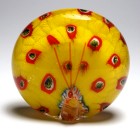
|
| 4459 | 1930s Chinese Footed Orange-Red Crimp
Rose Paperweight. circa 1930. This paperweight
is a well executed almost antique 1930s Chinese copy of a
Millville Crimp Rose. It has 11 orange-red colored petals
and four green leaves. The petals are arranged in a 4+4+3
pattern. There is a double foot at the base. As is
typical of Chinese paperweights from this period, the glass has a
greenish tinge and there are many tiny bubbles in the glass.
The South Jersey Crimp Rose is one of the most famous American paperweights. The best makers were Emil Larson of Vineland, New Jersey and Ralph Barber of Millville, New Jersey. There were also other makers. Newell's Old Glass Paperweights of Southern New Jersey shows examples of both the South Jersey weight and the 1930s Chinese copy. Chinese Paperweights were made in the late 1920s and throughout the 1930s as an attempt to duplicate 19th Century antique weights made in the United States and France. Because they are almost 100 years old, they are very collectible and every collector should own a few of these as study pieces. The history of the early Chinese paperweights is mostly anecdotal as no written records have been discovered. The story is that an American dealer sent examples of paperweights made by the New England Glass Company (NEGC), Boston & Sandwich Glass Company (B&S), Millville makers, and French factories to a Chinese factory and requested copies be made. The results are interesting and sometimes confused with the originals by inexperienced collectors. The earliest pictures of these paperweights appeared in the book American Glass Paperweights by Francis Edgar Smith published in 1939. Smith was aware that at least one of the paperweights shown in his book was Chinese. Since Smith was not an expert collector, this indicates that there was some general knowledge that these were Chinese prior to 1939. In the United States, the Tariff Act of 1930 required that every imported item must be conspicuously and indelibly marked in English with its country of origin. As a result, many of these Chinese paperweights are scratch signed on the bottom "CHINA". Many are also not signed, suggesting that either they were imported prior to 1930 or the importer ignored the requirement. Most likely the earliest Chinese paperweights were made prior to 1930. In general, Chinese paperweights from this period have a light weight glass mixture that is high in soda and has a greenish tinge. The glass also has a soft almost oily feel. Frequently they have bubbles or debris in the glass. And because of their age, many of these have minor scratches or other surface defects.
Size: 3 1/8" diameter by 3 7/16" high. The
base is just over 2 7/16" diameter and has a double foot.
The center is ground concave. For extra pictures, click on the picture at the right and the following links: Large pictureSOLD. Click on the picture to see a larger image. |
Click
on the picture to see a larger image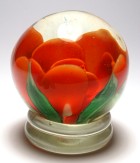 |
| 1537 | Magnum Chinese Blue Pedestal Rose
Paperweight. circa 1980-2000. This is a modern
Chinese blue pedestal rose paperweight with 30 blue colored petals
and five green leaves. The petals are arranged in six rings
in a 6+6+6+5+4+3 pattern. The design is set on a pedestal
stem with three knops and a white and green frit base. A
large example of a modern Chinese lampwork rose.
Unlike the 1930s copies of Millville crimp roses, this example thin petals and appears to be a lampwork assembly. Lampwork flowers are assembled at a hot torch (lamp) before being encased in glass. Crimp roses are made by a more difficult process that creates the rose in a single step using a metal crimp. Chinese Paperweights were made in the late 1920s and throughout the
1930s as an attempt to duplicate 19th Century antique weights
made in the United States and France. Because they are
almost 100 years old, they are very collectible and every
collector should own a few of these as study pieces. The
history of the early Chinese paperweights is mostly anecdotal
as no written records have been discovered. The story is
that an American dealer sent examples of paperweights made by
the New England Glass Company (NEGC), Boston & Sandwich
Glass Company (B&S), Millville makers, and French
factories to a Chinese factory and requested copies be
made. The results are interesting and sometimes confused
with the originals by inexperienced collectors. The
earliest pictures of these paperweights appeared in the book American
Glass Paperweights by Francis Edgar Smith published in
1939. Smith was aware that at least one of the
paperweights shown in his book was Chinese. Since
Smith was not an expert collector, this indicates that there
was some general knowledge that these were Chinese prior to
1939. Chinese paperweights continued to be made
throughout the 20th century and now into the 21st century with
greatly improved quality. Very large size: 3 9/16” diameter by 5 1/8”
high. The base is 3 1/4" diameter. The base is
ground flat. It weighs 46 ounces (2 pounds, 14 ounces). For extra pictures, click on the picture at the right and the following links: Large picture SOLD. Click on the picture to see a larger image. |
Click
on the picture to see a larger image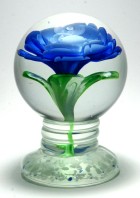 |
| 3222 | Chinese Pedestal Scrambled Millefiori
Paperweight, 1930s. circa 1930. This is a good
example of a Chinese 1930s pedestal form scrambled millefiori
paperweight. It has a great assortment of millefiori canes
and twist canes. Even though this was intended to be a copy
of a French scramble or end of day weight from 1845-1860 (probably
St. Louis or Clichy), the Chinese factory made it in a pedestal
form more common with paperweights from Millville, New
Jersey. Either way, it will not fool today's
collectors. Often these paperweights can be found scratch
signed "CHINA" on the base or more rarely signed with a cane
signature, but this example is unsigned. As
with most Chinese paperweights, this paperweight has a light
weight glass mixture that is high in soda and has a green-yellow
tinge. The glass has a soft oily feel and there
are some light scratches and small nicks. Good color and
condition. Note on condition: This paperweight is in very good condition for its age. It has an internal fracture on the base (see pictures) that is solid and is not spreading. It also has minor scratches but other cracks and no chips.
Large size: Just under 2 3/4” diameter by 3
1/4" high. The base is ground concave. For extra pictures, click on the picture at the right and the following links: Large picture$85 postage paid in the US. Click on the picture to see a larger image. Chinese Paperweights were made in the late 1920s and throughout the 1930s as an attempt to duplicate 19th Century antique weights made in the United States and France. Because they are almost 100 years old, they are very collectible and every collector should own a few of these as study pieces. The history of the early Chinese paperweights is mostly anecdotal as no written records have been discovered. The story is that an American dealer sent examples of paperweights made by the New England Glass Company (NEGC), Boston & Sandwich Glass Company (B&S), Millville makers, and French factories to a Chinese factory and requested copies be made. The results are interesting and sometimes confused with the originals by inexperienced collectors. The earliest pictures of these paperweights appeared in the book American Glass Paperweights by Francis Edgar Smith published in 1939. Smith was aware that at least one of the paperweights shown in his book was Chinese. Since Smith was not an expert collector, this indicates that there was some general knowledge that these were Chinese prior to 1939. In the United States, the Tariff Act of 1930 required that every imported item must be conspicuously and indelibly marked in English with its country of origin. As a result, many of these Chinese paperweights are scratch signed on the bottom "CHINA". Many are also not signed, suggesting that either they were imported prior to 1930 or the importer ignored the requirement. Most likely the earliest Chinese paperweights were made prior to 1930. The Chinese makers often combined design features found in paperweights from different makers. For example they copied the latticinio grounds used by New England Glass Company and used them with copies of Baccarat Pansy weights. The original Baccarat pansy paperweights never had a latticinio ground. They copied the pedestal rose from Millville and then used the pedestal bottom with other weights. It is fun to collect all the variations. In general, Chinese paperweights from the 1930s have a light weight glass mixture that is high in soda and has a greenish tinge. The glass also has a soft almost oily feel. Frequently they have bubbles or debris in the glass. And because of their age, many of these have minor scratches or other surface defects. Chinese paperweights made in the 1970s and later usually have better quality glass and are free of debris. |
Click
on the picture to see a larger image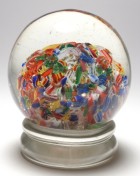 |
Revised 8/7/2025 EI9